
GORDON WILLIAMSON, illustrated by IAN PALMER
KRIEGSMARINE U-BOATS 1939-45
The standard method of communication between a U-boat and its shore- based command was the short-wave radio, operating on the 3-30 MHz range. Most U-boats were fitted with a combination of a Telefunken receiver, and a 200-watt Telefunken transmitter with a smaller 40-watt Lorenz transmitter as back-up. Once at sea, communication between U-boats utilised medium-wave radio on the 1.5-3 MHz range. Once again, the equipment was manufactured predominantly by Telefunken. Finally, signals sent to U-boats whilst submerged required the use of very long wave signals on the 15-20 MHz range. These required an enormously powerful transmitter on land, but were the only sure way of making contact with a submerged boat. These signals were also received on the same Telefunken equipment as the medium-wave signals.
Basic radar equipment began to be installed on U-boats in 1940. The earliest operational type was the FuM029 (Funkmessortungs Gerät). This was predominantly used on the Type IX, but a few Type VIIs were also fitted with this equipment, easily detected on photographs because of the twin horizontal rows of 8 dipoles on the upper front part of the conning tower. The top row were transmitters and the lower row receivers. An improved version, FuM030, was introduced in 1942 in which the tower-mounted dipoles were replaced by a so-called retractable 'mattress' antenna which was housed in a slot in the tower wall.
This equipment was only partially successful in detecting other ships due to the very low position of its mounting in respect to the ocean surface (on surface ships, the radar is usually mounted high up on the mainmast or bridge top). Interference with the radar signal by the ocean surface in heavy weather meant that enemy ships might be detected visually before being picked up on radar. An improved version, the FuMO61, was little better in this respect but did provide good aircraft detection results.

U-462 seen during a mid-ocean refuelling operation. The fuel pipe can be seen trailing from her stern.
A new type of radar, the FuMB1 (Funkmesserbeobachter), also known as Metox, was introduced in July 1942. This equipment was used in conjunction with an extremely crude wooden cross-shaped antenna strung with wire and known as the 'Biscay Cross'. This antenna had to be rotated by hand. Unfortunately, the Metox's own emissions were detectable by Allied radar detection equipment, leading them straight to the U-boat. A later, improved version, the FuMR9 Zypern, was also found to be detectable by the British H2S radar detection system. Not until the FuMB10 Borkum set did the U-boat have a radar detection system that was not itself detectable.
This still left the problem of the existing equipment not covering the full radar spectrum, a problem eventually solved in November 1943 by the FuMB7 Naxos. Naxos and Metox used together finally gave the
U-boats excellent all-round radar detection capabilities. The range of capabilities of Naxos and Metox were finally combined in a single system with the introduction of the FuMB24 Fliege and FuMB25 Mäcke systems in April 1944.

A Type IIB is beginning its dive. As the boat slips below the surface, the diesel air intakes and exhaust vents are automatically sealed as the engine shuts down and the electric motors take over. Note the pedestal fitted to the foredeck for the 2 cm flak gun.
The earliest form of sound detection equipment used on U-boats was the Gruppenhorchgerät (GHG) installed in early vessels. The sound detectors were installed in the hull on either side of the bow, so that sound detection was only truly accurate when the boat was abeam of the vessel being detected. Improved sound detection came with the Kristalldrehbasis Gerät (KDB) in which the sound detection array was contained in a rotating, retractable mount set into the foredeck. This was the system carried on most Type VII vessels. A number of Type VIIs were also equipped with the so-called Balcon Gerät (Balcony Apparatus) set into a 'balcony'-shaped faring in the lower part of the bow. This gave a far better effective field than either the GHG or KDB systems.
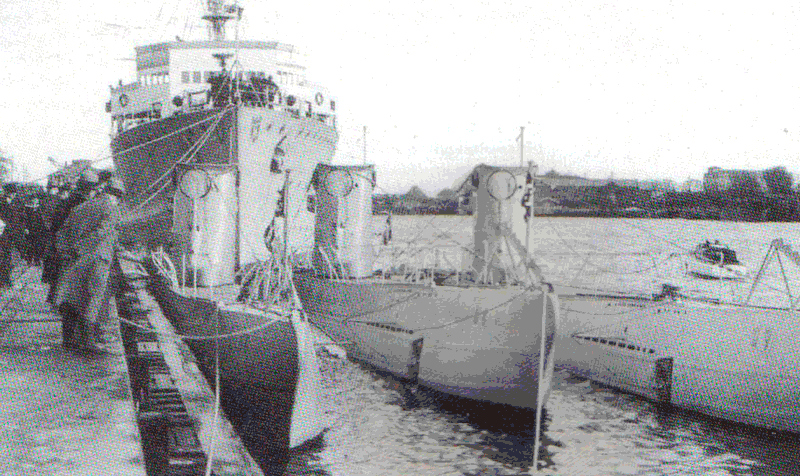
Three Type IIBs of the Weddigen Flotilla, tied up to their support ship, the Unterseebootsbegleitschiff Saar. Prior to the outbreak of war, all boats carried their number painted in black or, most commonly, white on the side of the tower, as well as on a small plaque on each side of the bow.
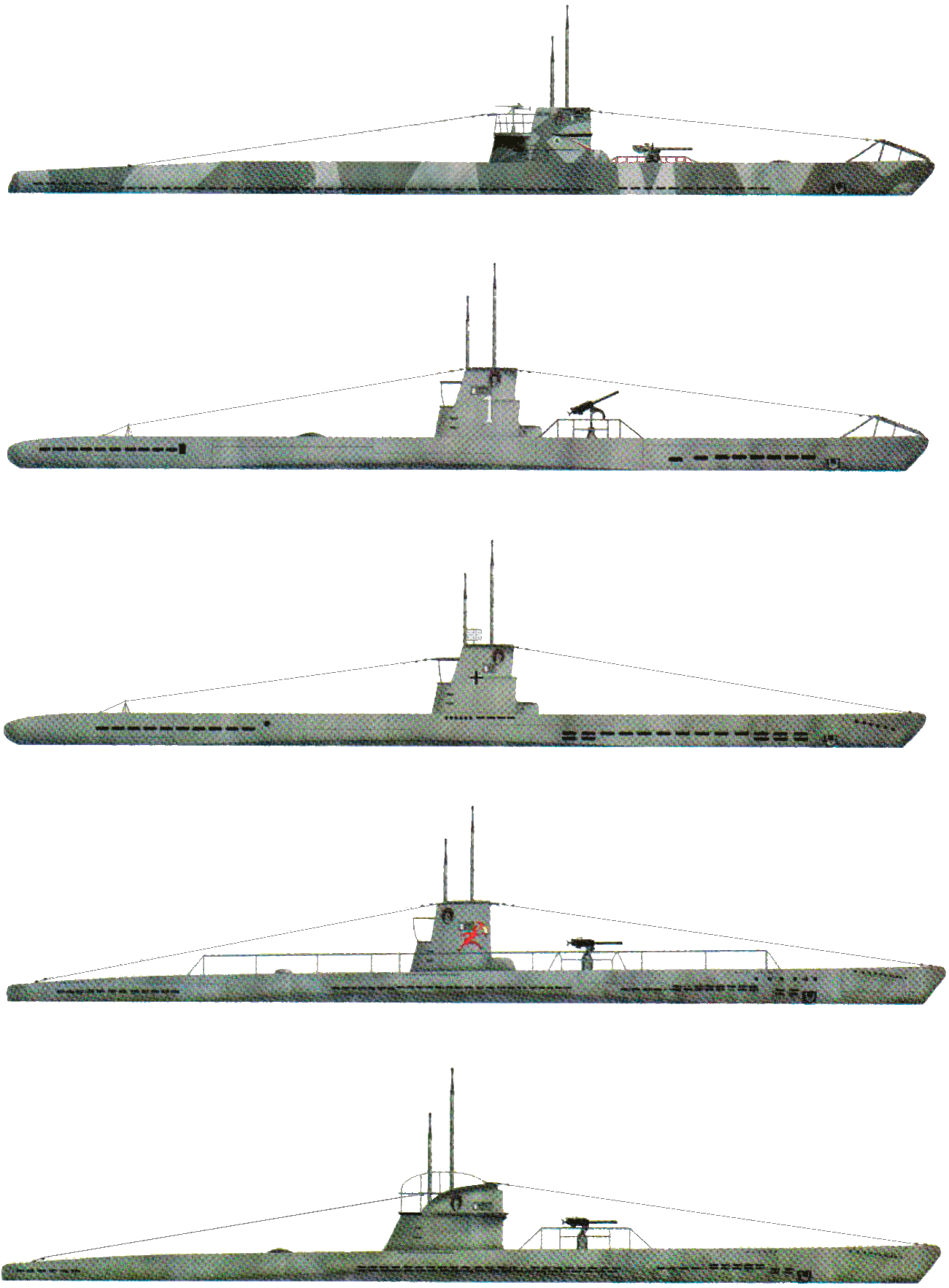
Shown here are the early Kriegsmarine U-boats, most of which played little part in the Second World War beyond training duties.
1) Type IA. This U-boat, of which only two were built, did in fact see combat service, with both examples of the type, U-25 and U-26, being sunk in the summer of 1940. U-25 is shown here in the livery in which she undertook her first war cruise. After this first cruise, the shark's teeth on the conning tower were painted out. The two- tone grey camouflage was use fairly widely on other boats, particularly the Type VIIC.
2) Type IIA. The first of the Type II boats, U-1 as shown here is in its pre-war livery of pale grey with the boat's number painted on the side of the tower. The number was also carried on a small plaque at either side of the bows. Both were removed on the outbreak of war. In reality, the 2 cm gun it was capable of carrying seems rarely to have been mounted on Type IIAs.
3) Type IIB. Shown here is U-9, the 'Iron Cross Boat'. Very similar in appearance to the Type IIA, it was marginally longer to accommodate more fuel bunkerage. Later examples of the IIB had a flush rather than stepped front to the tower. Carrying the traditions of the famed U-9 of the First World War, this boat carried a large metal Iron Cross emblem on the side of her tower. This was removed on the outbreak of war.
4) Type IIC. Again, very similar in appearance to its predecessors, the 'C' variant was slightly longer but was easily identifiable by the additional draining ports for the free-flooding area between the outer hull and pressure hull. These are visible along the centre of the boat just below the tower. The Type 110 is usually found in period photos with the 2 cm deck gun mounted.

A close-up of the flak armament on U-377 after her bridge conversion. The upper platform is home to two twin 2 cm flak guns, whilst a four-barrelled Flakvierling is mounted on the lower platform. Unusually, no gun shields have been fitted to the Flakvierling in this case. (Jak P. Mallmann-Showell)
5) Type IID. The Type IID is easily identified by its very distinctive conning tower shape. Shown here on U-143 is the early tower shape with its large, curved railings to the rear. Later towers were very similar to those on the Type VII, with a flak gun platform to the rear. Shown here in light grey livery, this boat is known to have used a two-tone grey camouflage pattern, similar to that shown for U-25, during her combat service in the Second World War.
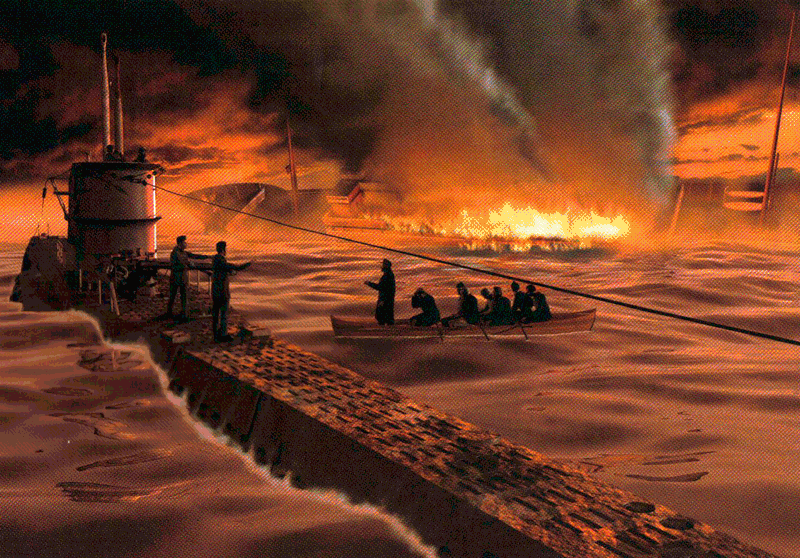
B: THE SURVIVORS OF A U-BOAT ATTACK
During the early part of the Second World War, many merchant ships still travelled alone. Escorts were in short supply and air cover was restricted, so several U-boats took the time to question the survivors in an attempt to confirm the identity of the sunken ship, knowing that the chance of the enemy appearing was slight.
Here, a Type VIIA has just sunk a merchantman and the crew watch as survivors are beckoned over by the captain. Space on a Type VII U-boat was extremely restricted, so the taking on board of survivors was a rarity. In several recorded cases, U-boat captains would check to ascertain if any of the survivors were wounded or needed medical attention, and were known to provide the survivors with the odd bottle of brandy and a course for the nearest safe landfall before disappearing under the surface again.
As the war progressed and anti-submarine measures grew in their effectiveness, few opportunities for such niceties would occur, as any boat coming to the surface put itself in the greatest danger. After the Laconia incident, when U-506 was bombed despite clearly having a number of survivors, including women and children, on her decks and towing a number of lifeboats, Grossadmiral Dönitz as Commander in Chief U-boats ordered that no U-boat commander should put his boat and its crew at risk by attempting to rescue survivors. This order, however, was occasionally disobeyed.
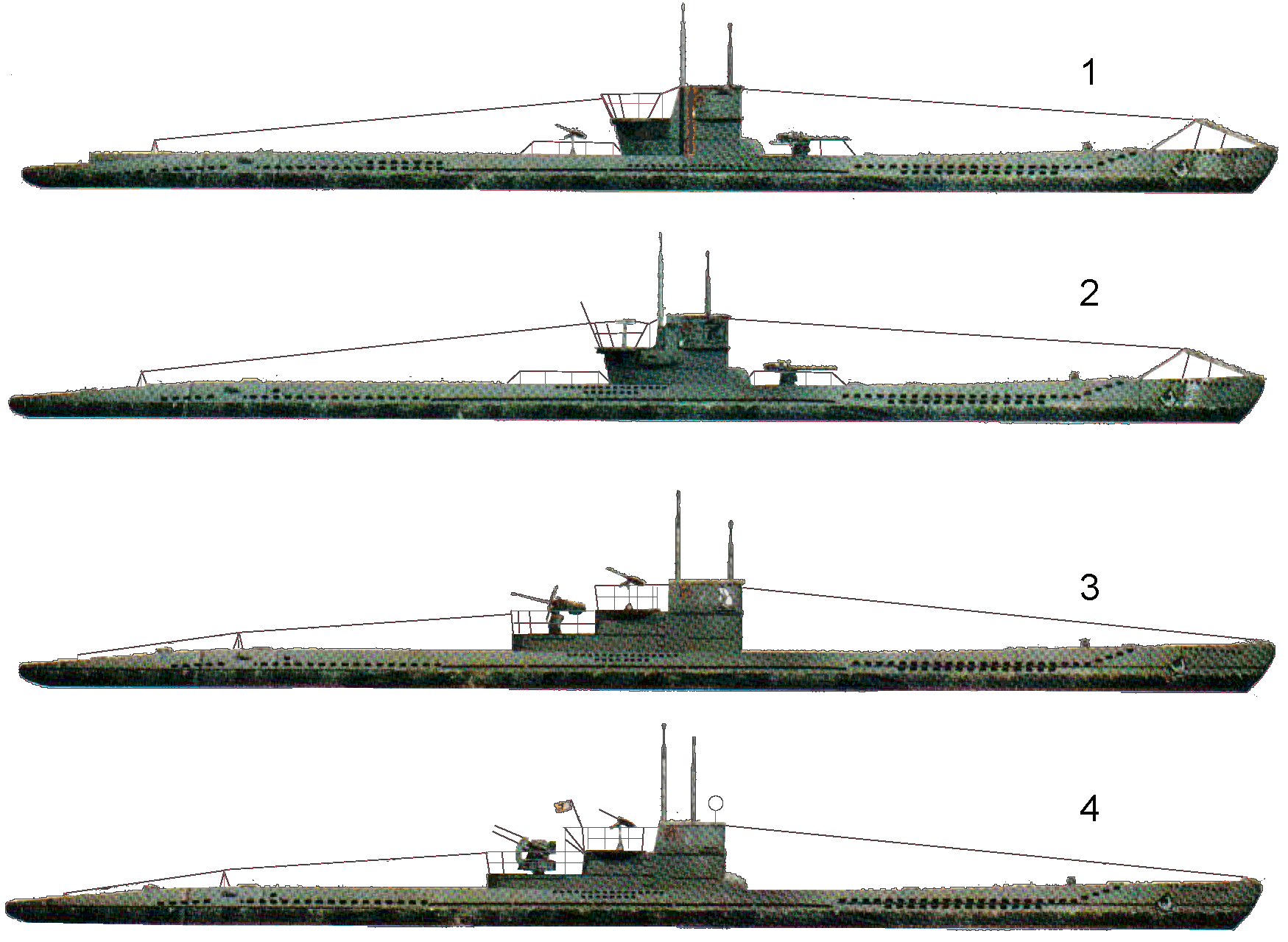
This plate shows the remarkable range in appearance between different variants of the Type VII U-boat.
1) Type VIIA. The earliest of the Type VIIs is instantly recognisable by its prominent stern torpedo tube, mounted outside the pressure hull. Note also that the 2 cm flak gun is still mounted on the afterdeck and has not yet moved to the bridge platform. Shown here is U-29 whilst on nonintervention patrol duties during the Spanish Civil War. The red/white/black recognition stripes were carried by all German warships on duty in Spanish waters.
2) Type VIIB. Shown here is U-101, with the later style of bridge for this model, the 2 cm flak gun having been moved up from the afterdeck and with prominent air ducting up the side of the tower to draw in fresh air for the boat's diesel engines.
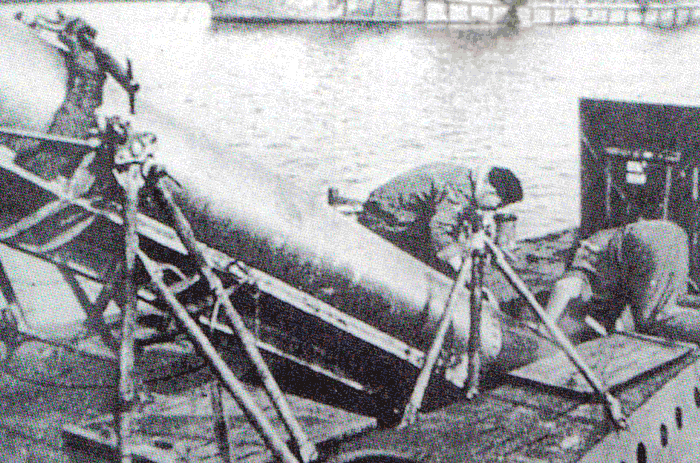
A torpedo is introduced to the interior of a Type VII through the torpedo loading hatch on the foredeck. This is a complex enough operation when in the calm of the boat's home port, and one can imagine just how difficult this would be if the boat was being resupplied whilst on the open seas.
3) Type VIIC. This is U-995, a typical Type VIIC in late-war configuration, launched in 1943. It has a 3.7 cm flak gun on the lower 'Wintergarden' platform, and two twin 2 cm flak guns to the upper. Surviving the war and nine war cruises, she was handed over by the Allies to the Royal Norwegian Navy who used her up until 1965 before decommissioning her. She was then presented to the German Navy, restored, and may now be visited by the public adjacent to the German Naval Memorial at Laboe, near Kiel.
4) Type VIIC/42 This, the ultimate Type VII, was to have the extended lower Wintergarden' mounting a quadruple 2 cm Flakvierling, with two twin 2 cm flak guns on the upper platform, giving it formidable defensive firepower. In the event, even the enormous firepower wielded by the special Flak Boats proved inadequate against determined air attack, so all of the 165 examples of this boat which had been ordered were cancelled.
D: INTERIOR LAYOUT OF A TYPE VIIC/42
SPECIFICATIONS
Length: 67.1 m
Beam: 6.2 m
Draught: 4.8 m
Displacement: 761 tons
Speed: surfaced 17 knots submerged 7.6 knots
Range: 6,500 nautical miles
Crew: 44
Armament: 14 torpedoes, 2 × twin 2cm Flak guns, 1 × quad 2cm Flak gun
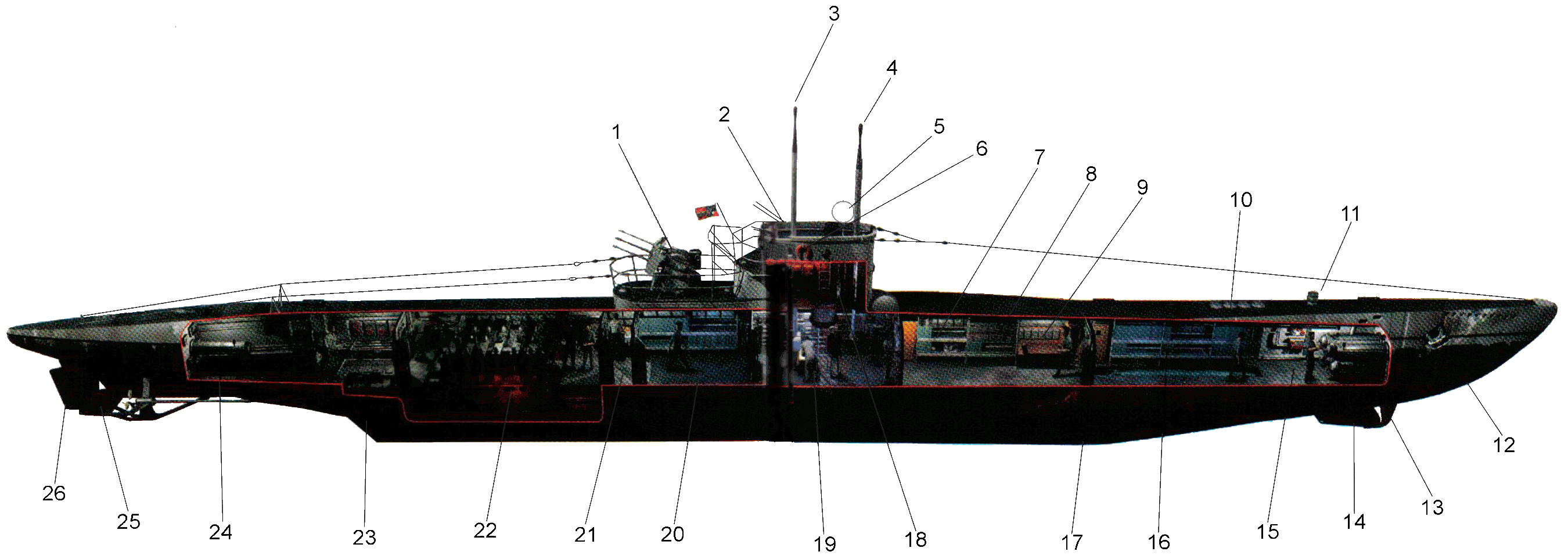
1. Quad 2 cm flak gun
2. Twin 2 cm flak gun
3. Navigating periscope
4. Attack periscope
5. Direction finding loop
6. Lifebelt
7. Commander's accommodation
8. Officer accommodation
9. Senior NCO's accommodation
10. Watertight containers for inflatable life rafts
11. Capstan
12. Anchor
13. Bow hydroplanes
14. Bow torpedo tubes
15. Forward torpedo room
16. Junior ratings' accommodation
17. W.C.
18. Commander's attack position
19. Control room
20. Petty officer's accommodation
21. Galley
22. Diesel engines
23. Electro-motors
24. Stern torpedo tubes
25. Stern hydroplanes
26. Rudder
The interior layout of the Type VII was fairly typical of German submarine design. At the bow end was the forward torpedo room, with its four tubes and accommodation for junior ratings. Storage space was also provided under the floor plates for additional torpedoes. At the roof of the after end of this compartment was an angled hatchway for loading fresh torpedoes into the compartment.
Through the bulkhead, moving aft, is the senior ranks' accommodation and captain's cabin, built over the forward battery stowage. Directly across the walkway from the captain's cabin were the radio and sound rooms. In the centre of the boat was the control room, containing the main helm, diving controls, navigator's table and the auxiliary bilge pumps. On the port side were the periscope motor, main vent controls, main bilge pump and a drinking water tank. In the centre of the compartment were the tubes into which the periscopes retracted.
Above the control room was the conning tower, in which was the commander's attack station. Within this tiny compartment were the optics for the attack periscope, the attack computer, the compass and the exit hatch to the exterior of the conning tower. Under the decking of this section were fitted ballast tanks and fuel bunkers.
Moving aft, the next compartment is the junior noncommissioned ranks' accommodation. Towards the rear of this compartment were the galley, the aft w.c. and the pantry. Under the deck plates of this area were the aft batteries.
The next bulkhead led through to the engine room containing the boat's two diesel engines on their massive founds, with only a narrow passageway in between. A further bulkhead allowed passage into the motor room in which were located the boat's two electric motors, coupled to the same shafts as the diesels. Also contained in this compartment were a compressor for the boat's modest refrigerated storage, the main electrical control panels and the stern torpedo tube, firing out between the boat's twin rudders. Beneath the deck plating in this area were the stern trim tanks.
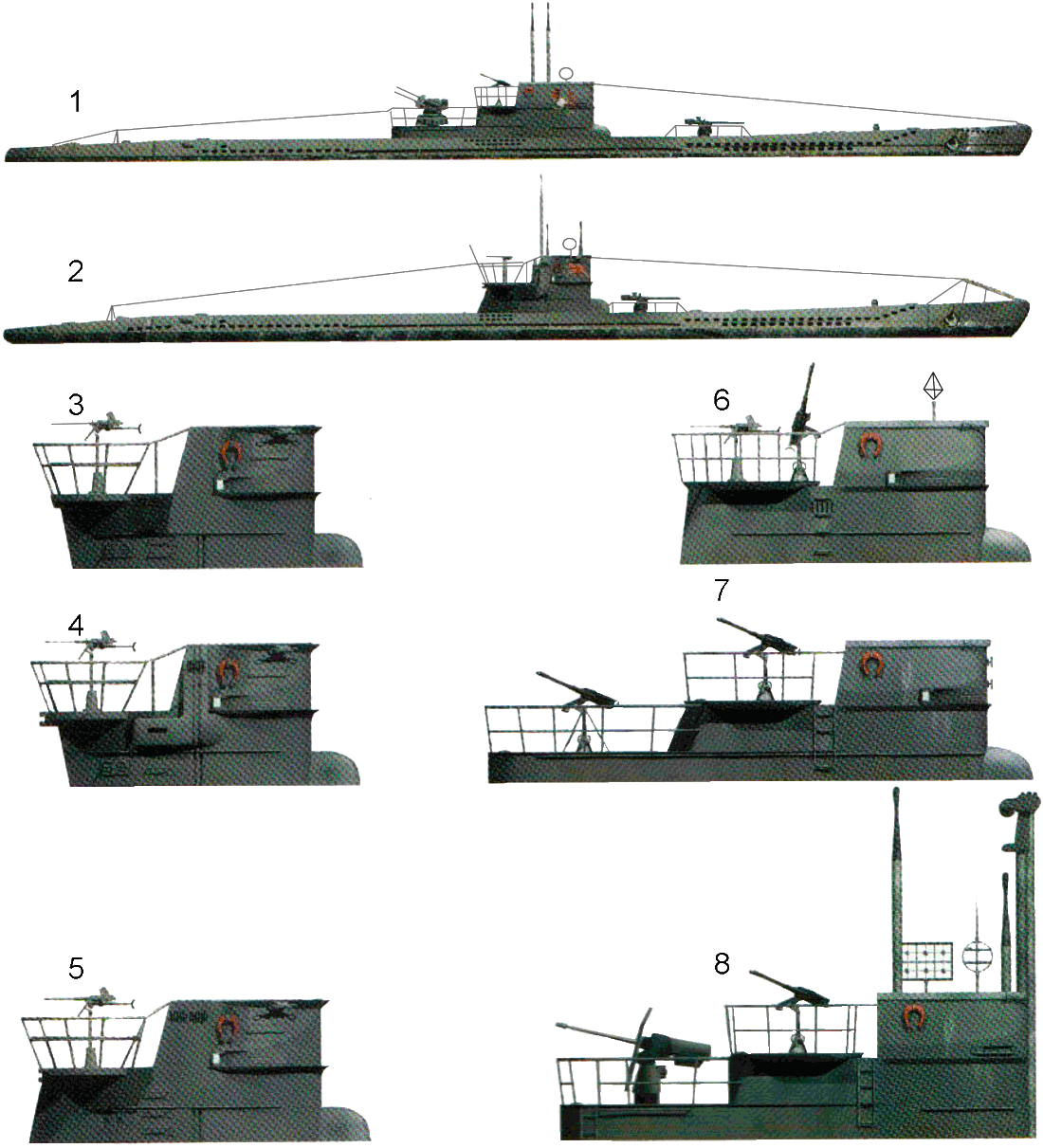
E: DECK ARMAMENT CONFIGURATIONS ON THE TYPE VII
1) Type VIIF. Only four examples of this extremely large type were completed. A 10.5 m 'plug' was inserted into the hull abaft the conning tower, allowing this version to carry 24 additional torpedoes. Externally, apart from the extreme length, this type bore a strong resemblance to the standard Type VIIC/41.
2) Early Type VIIC. This is the boat with which the Germans fought the first part of the war at sea. The basic Type VIIC has the 8.8 cm deck gun still fitted and a single 2 cm flak gun on the tower platform. This illustration shows Heinrich Lehmann-Willenbrock's famed U-96 with its laughing sawfish emblem.
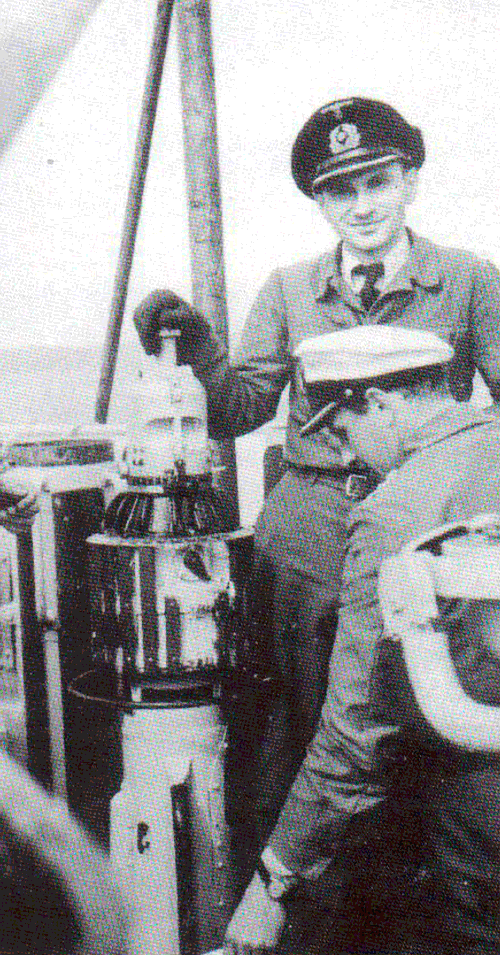
One of the most important pieces of equipment on the bridge of a U-boat was the Uberwasserzieloptik, generally referred to as the UZO. A pair of special binoculars was attached to the top of this pedestal device and used to transmit target settings for the torpedoes. The IWO, Oberleutnant Pietschmann, rests his gloved hand on the UZO on the bridge of U-377, a Type VIIC. (Jak P. Mallmann-Showell)
3) The Type VIIA bridge as designed had a flush forward face, the spray deflector half-way up the tower berg a later addition to the design. Early towers had a simple flared upper edge to deflect spray and had no armament mounted on the upper platform.
4) The Type VIIB bridge was modified soon after introduction, to accommodate a large air intake trunk up the outside of the tower. Most Type VIIBs had the spray deflector fitted at the mid-point of the tower and this type also saw the 2 cm flak gun moved up from the afterdeck.
5) The standard early Type VIIC Turm 0 featured the basic armament configuration, known as 'Turm 0' with typical round platform and 2 cm flak gun. Most Type VIICs were retrofitted with a spray deflector lip rather than having the edge of the tower itself flared as in earlier models.
6) A few examples of the Type VIIC had the width of the platform between the rear 2 cm flak gun mount and the bridge widened to allow the fitting of two twin 2 cm flak guns.
7) The bridge of the Type VIIC Turm 2 conversion saw the addition of a second round platform, on a lower level, to the rear of the upper platform. It also carried a single 2 cm flak gun.
8) The Type VIIC Turm 4 was the bridge configuration found on most late-war Type VIIs. The wide upper platform featured two twin 2 cm flak guns side by side, whilst the lower, lengthened platform featured a single 3.7 cm flak gun or occasionally a quadruple 2 cm Flakvierling.
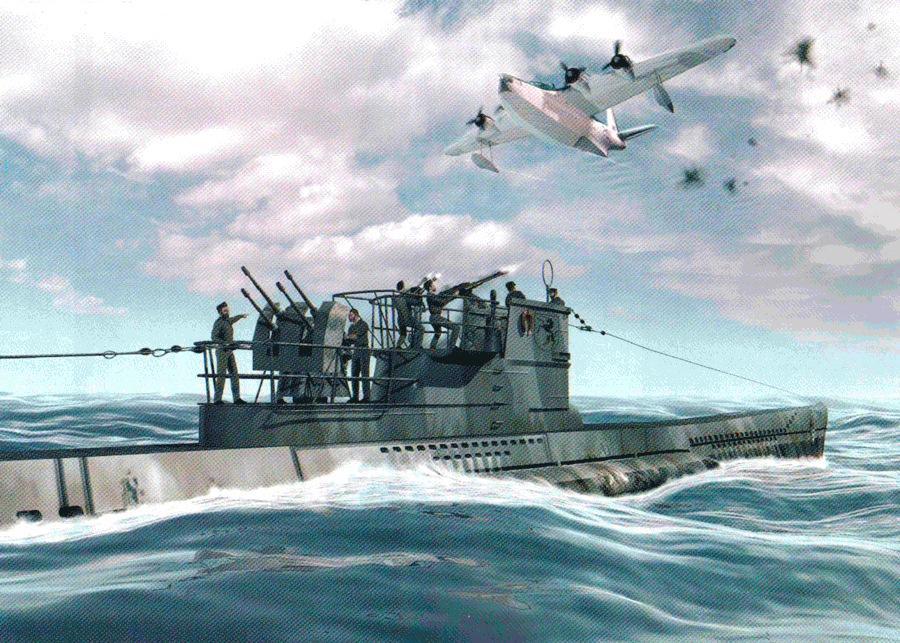
Although most late-war U-boats boasted a fairly formidable complement of anti-aircraft weaponry, the chances of a U-boat fighting off an air attack were very slim. It did, however, occasionally happen, and there are a number of recorded cases of U-boats successfully escaping after shooting down an attacking aircraft. But in most cases, the U-boat dared not risk placing itself in a position of defencelessness by recalling its gun crews in order to dive, and so was forced to remain on the surface if the aircraft's pilot was smart enough merely to stand off out of range of the U-boat's flak guns. The aircraft would simply call up reinforcements and wait until several could attack the boat at once. The few successful occasions where U-boats shot down enemy aircraft tended to be when the aircraft attacked alone before support arrived.
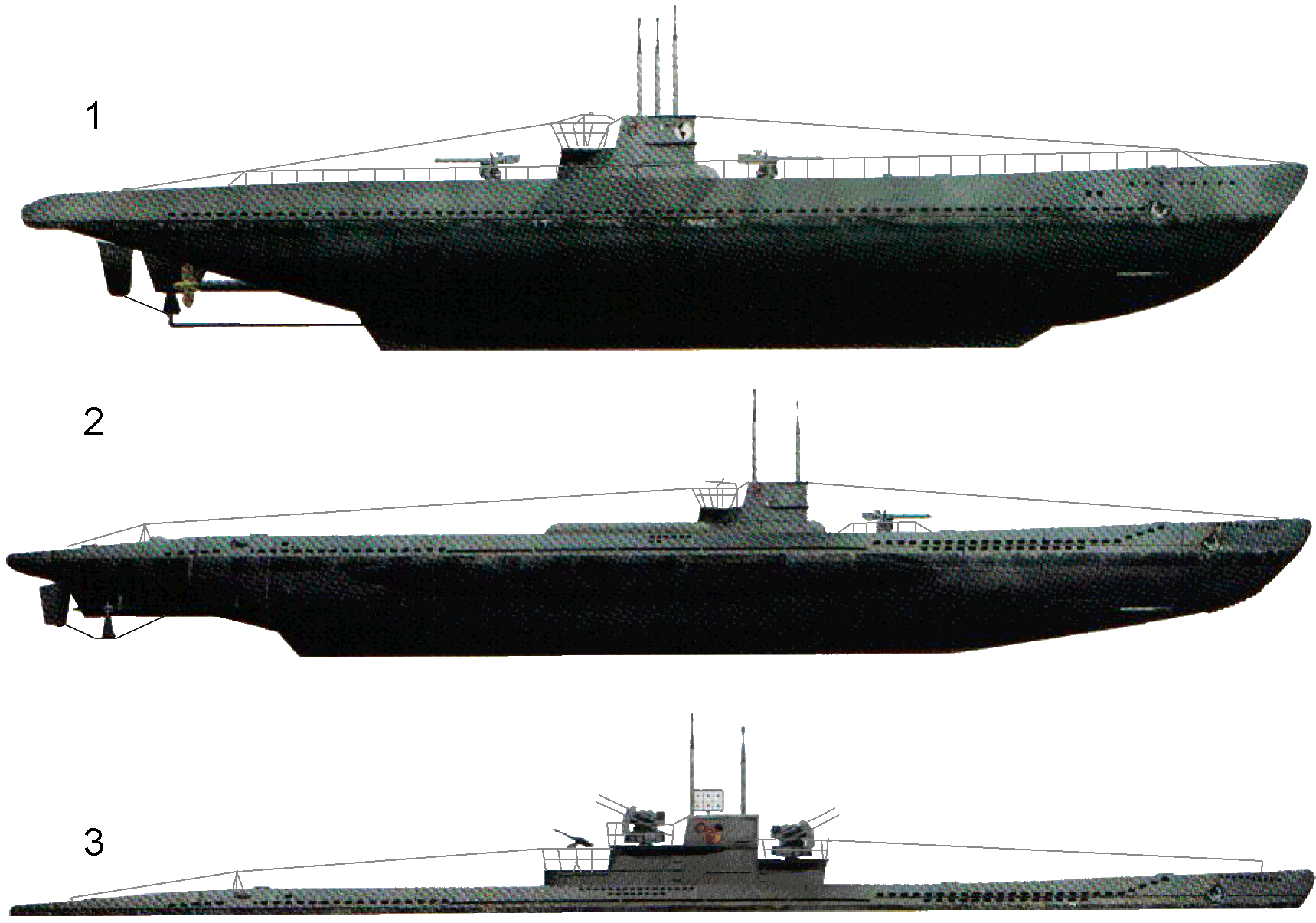
1) Type XIV. The U-boat tankers, as can be seen from this full-hull view of the Type XIV U-460, in comparison with the Type VIID which follows, had an enormous capacity. These boats performed excellent work in resupplying U-boats in distant waters but were tracked down one by one, predominantly through the interception of German coded radio signals.
2) Type VIID. The minelaying Type VIID was instantly recognisable by the raised decking abaft the conning tower, which contained the openings to the mine storage tubes. Only six were commissioned, of which five were lost in action. Only U-281 survived the war.
3) Flakboot. Seven basic Type VIIC vessels were converted for use as flak 'traps'. In the earlier days of their use, some Allied aircraft received a nasty surprise on attacking what they thought to be a normal U-boat, only to be met with the concentrated fire of eight 2 cm flak guns (two quadruple Flakvierlinge) and one 3.7 cm flak gun. The Allies, however, soon developed the tactic of standing off until support arrived and attacking the Flak Boat en masse. These boats were also very slow to dive and had poor handling characteristics because of the additional weight and drag when submerged. With their usefulness in doubt, in November 1943, all Flak Boats were re-converted to standard Type VIIC configuration.
We have much more interesting information on this site.
Click MENU to check it out!
∎ cartalana.com© 2009-2025 ∎ mailto: cartalana@cartalana.com